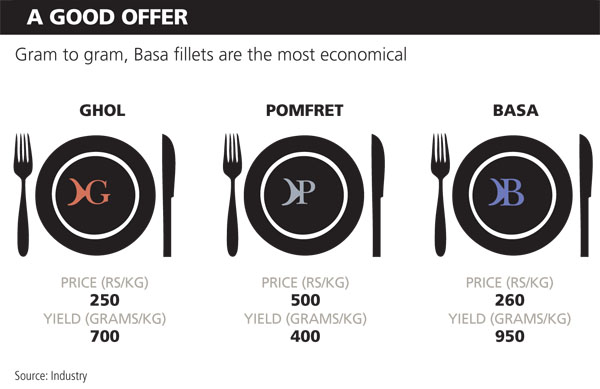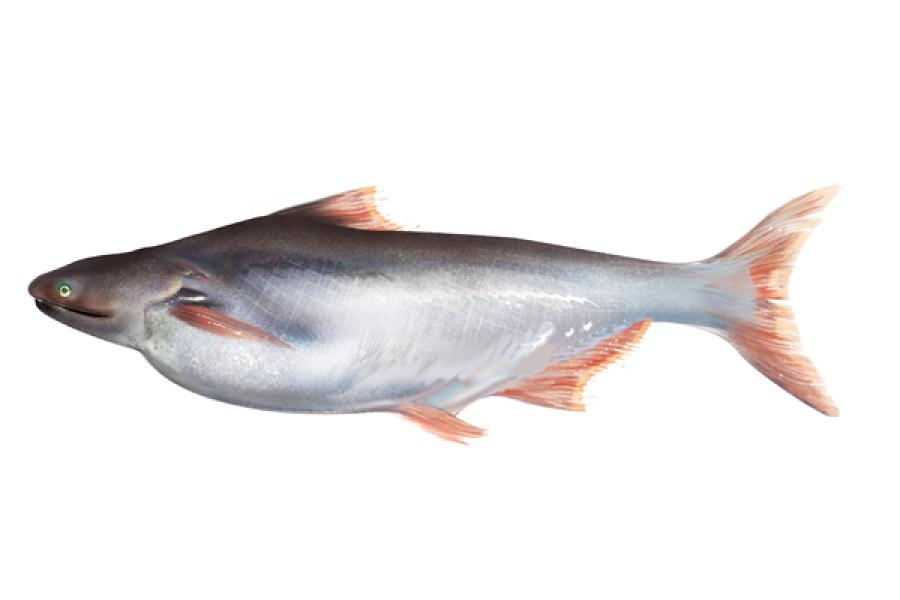
A Fish Called Basa
Largely from Vietnam, its rapid spread and acceptance in India in the past three years have left experts baffled, and beaming
Yogesh Grover smelled a rotten fish when, in 2007, he moved to India.
After having worked in Africa and Europe, Grover, director of Empire Foods, was left cold by the quality of fish being served in Indian restaurants.
“Even marquee five star restaurants were serving quality that was bad for the price they were charging,” he says. Grover loves fish: Chilean Seabass, Scottish Salmon and Silver Pomfret are his favourites. In a moment of chagrin that is known to come over fish lovers, he remembered the white fish that he had eaten in Europe and placed a trial order of six tonnes of Vietnamese Basa.
That order changed the way Indian hotels serve fish.
Three years after the first Vietnamese consignment landed on Indian shores, imports of Basa have touched around 1,500 tonnes. “In 2011, it should cross 2,000 metric tonnes,” says Rahul Kulkarni, director, marketing, West Coast Group, which imports and sells Basa in retail outlets under the Cambay Tiger brand. Data from the Directorate General of Foreign Trade shows that so far in 2011 India has already imported three-fourths of what it imported in the whole of 2010.
The success of Basa has been so swift that even long-time restaurateurs have been left stunned. “I can’t recall an instance when a fish from another shore has worked its way into the Indian palate so quickly. It is phenomenal,” says Anjan Chatterjee, founder, Speciality Restaurants, which owns Mainland China and Oh! Calcutta. Chatterjee serves Basa in both these restaurant chains.
The rising popularity of Basa means it is replacing the stock fish — River Sole in North India, Bhetki in East India and Ghol or Pomfret in West India — in hotels across India.
This doesn’t mean restaurants don’t serve Indian varieties. They do, but for many dishes that need a fillet for the recipe, Basa is now the fish of choice. And not just for the economics.
From the Mekong Delta
Basa is a harmless little name for the more formidable Pangasius Bocourti. It comes from a huge family of catfish that grows in Vietnam, Thailand, China and Cambodia. Vietnam is the dominant player by far and, according to the World Wildlife Fund (WWF), is the source of 99.9 percent of Pangasius (also known as tra and basa catfish) exports. And the volume of exports has expanded 50-fold over the past decade. “Basa has conquered Europe and it has been accepted in the USA,” says Grover. (In the USA, Basa has fought a bitter war for the catfish title, but more on that later.)
Most of the Basa sold in the global markets is farmed. There is an interesting history to it. Paul Greenberg, a food policy expert, writes in the New York Times: “Ethnic Vietnamese living in exile in central Cambodia used cages suspended below floating houseboats on Cambodia’s Great Lake, or Tonle Sap, to breed this fish for their consumption. They fed the fish rice bran and fish meal.”
Basa has low oxygen demands and breeds very quickly, making it perfect for being farmed. Over the past two decades, the Vietnamese have perfected the manufacturing processes that keep the fish fresh. Once they are filleted, they are immediately freeze dried and packaged such that they remain fresh even after they are transported miles away. And to top it all, they do it very economically.
To understand how economical the process is, compare the rates that Indian hotels have to pay for a kilogramme of fish of different varieties, along with the yield of meat they get from each. There is hardly a contest because Basa wins hands down.

Infographic: Sabreen Aziz
Why Choose Basa?
What is the secret of such high yield of Basa? “There is no other fish that can be as easily de-scaled and de-boned,” says P.B. Reddy, director, Castlerock Fisheries. Basa has just one, long, central bone and once that is taken out, making the fillet is easy.
The Vietnamese entrepreneurs have invested good monies to make boats that have an aquarium-like attachment on the hull of their boats. This keeps the fish alive and fresh till they reach the processing plant. Chatterjee thinks the Vietnamese production techniques are ‘magic’, since the fillets feel absolutely fresh when taken out of the packet. Hemant Oberoi, executive grand chef at Mumbai’s Taj Mahal Palace, agrees. “It is a nice firm fish. Cleaning is quick, it is frozen and there is no wastage. After thawing, it is as fresh,” he says. He also likes its versatility. He reckons it is good for steaming and frying and it also poaches well. “We were using rock fish, Rawas and some Pomfret. We have replaced these with Basa,” he says.
Perhaps the biggest virtue that the Vietnamese bring with this fish is the promise of reliable supplies. In India, sea fish is seasonally available between September and May. For instance, Mumbaiites love Bombay Duck, but it is available from February to May and the Indian Mackerel is available from September to November. “The price of fish such as King Fish [Surmai] and the others are quite high due to their seasonality and only a small section of the population can eat it regularly,” says Reddy. With Basa, all this is overcome.
What about the taste of this fish? Basa adapts very well to Indian and other Asian cuisines such as Chinese and Thai. Chefs concur that it can easily be tava-cooked or masala-grilled. “It gels well with the kind of palate Indians have. It is softer [than other Indian fish],” says chef Anirudhoya Roy of Taj Land’s End, who pioneered the use of this fish in Indian hotels. Today, Roy uses 600 kgs of Basa a month.
Another strong attribute of Basa is that it doesn’t smell, which puts it in a sweet spot. Indian sea fish such as Mackerel or King Fish are less bony than fresh water varieties, but are smellier. Fresh water fish such as carps smell less than sea fish but have many bones. Visually too, Basa scores. The premium grade of Basa imported into India, is unblemished white. “People like to see white meat when they cut into it. Whiteness is always associated with good quality,” says Reddy.
The Bony Bits
But Basa isn’t without controversies. Nothing that successful ever is. In 2002, the US Department of Commerce upheld the appeal of American catfish farmers and slapped a dumping duty on the fish. Later, the US Food and Drug Administration (FDA) launched an investigation into the farming practices of Basa. Vietnamese fish farmers were accused of using unhealthy antibiotics to increase its yield.
Some of these allegations were perhaps true once upon a time because the industry was then fragmented. Now, thanks to the WWF, quality consciousness is higher. A later US FDA inspection did not find anything objectionable. “This fish would not have been accepted all over the world if the chemical and toxin claims were true. Now they use it in France also, and in the Middle East. We have also checked Basa samples multiple times and keep checking it in our own microbiology lab,” says Oberoi.
The farming of Basa has started in eastern India’s fresh waters as well. The region produced 30,000 tonnes of the fish in 2010 and it is being served all over the North (including Delhi) and the East.
But, where look and taste is concerned, Indian Basa is yet to make the cut. Its colour is dimmer and the bloodstreams running across the flesh are visible. For these reasons the price of Indian Basa is lower, at Rs. 170 to Rs. 210 a kg, while the Vietnamese variety sells for Rs. 240 to Rs. 270 a kg. “Between September and November 2010, there was so much Basa produced locally, that the price fell to Rs. 35 per kg,” says Reddy.
Indian fishery experts think that in a few years aquaculture within the country will start delivering quality Basa. And they would not be the only ones. Apparently, the Chinese have taken a shine to this fish and have started ramping up its production.
Then, there will be more than just troubled waters between India and her neighbour.
(This story appears in the 25 March, 2011 issue of Forbes India. To visit our Archives, click here.)
-
 Raynid
RaynidBasa is wealth from Vietnam water
on Mar 27, 2011















